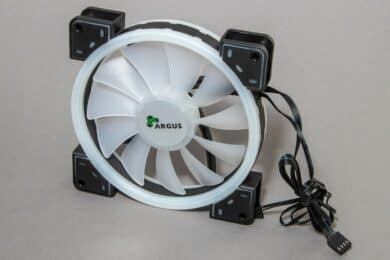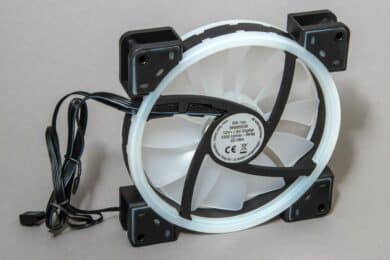Inter-Tech sells a large number of brands and a variety of product categories from the PC sector. Among them are, for example, the Argus RS-14 RGB fans, which we put to the test here. At first glance, these fans stand out from the crowd in several ways. At 140 mm, they are suitable for larger cases, and yet they come in an inexpensive pack of three. And for this you pay less than for some regular fans individually. That being said, they are RGB fans that have both an illuminated frame and illuminated fan blades. However, we’ll take a closer look at what the performance does in the Inter-Tech Argus RS-14 review.
Specifications
| Scope of delivery | 3 fans and RGB controller with remote control |
| Accessories | 3-way PWM splitter, extension cable, screws |
| Fan size | 140 x 140 x 25 mm |
| maximum speed | 1200 RPM |
| Fan connector | 4-pin PWM |
| RGB connector | Proprietary with adapter to standard ARGB |
| LEDs | 26 per fan |
| Fan bearing | Sliding bearing |
| Guarantee | 2 years |
| Price | € 31.60 * |

€ 31.60
€ 35.97
Gewöhnlich versandfertig in 4 bis 5 Tagen.




€ 19.29
Lieferung in 1 Werktagen nach Zahlungseingang Versand nach: Worldwide




€ 24.60
Lagernd im Versandlager – Lieferzeit 2-5 Werktage




€ 25.39
Zentrallager: verfügbar, Lieferung 3-5 WerktageFiliale Wilhelmshaven: nicht lagernd




€ 25.40
Lagernd im Außenlager, Lieferung innerhalb 3-5 Werktage
Packaging and scope of delivery
- Simple packaging with multiple fans
- RGB controller
- Screws, cables and splitters
The packaging of the Inter-Tech Argus RS-14 is kept relatively simple. However, I would not expect more in this price range. In the green and white box, the three fans sit unpadded right next to each other, and next to them you’ll find the white box with the surprisingly extensive accessories.
Along with the Inter-Tech Argus RS-14 comes a matching RGB controller. In addition, there is the corresponding remote control.
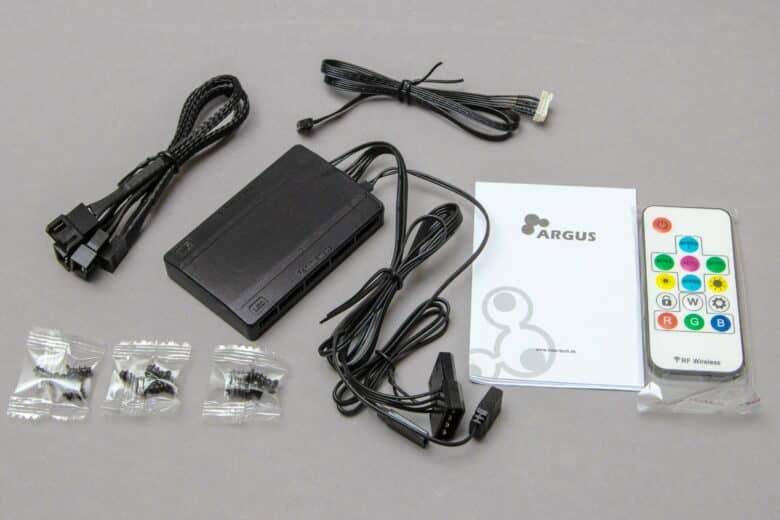


Apart from the manual and the RGB controller with adapter to standard ARGB, there are the obligatory fan screws, an extension cable and a fan splitter. The latter can be used to connect the three PWM fans to a header on the motherboard.
Design
- Lighted frame front and rear
- Lighted fan blades
- Unobtrusive cables
The Inter-Tech Argus RS-14 are already quite large fans with their 140 mm in height and width. However, due to the width of the frame, the Argus RS-14’s fan blades are slightly smaller than some other 140mm fans. All of the illuminated parts of the frame and fan blades are a milky white. In contrast, the structural parts of the frame are in stark contrast due to their black color.
The cables are both positive and negative. The black, thin cables are relatively unobtrusive and should be long enough for most applications. The only negative is the general cable tangle that results from two cables per fan. But well – most RGB fans have this problem, even in much higher price ranges.
You can still see a bit of the milky white surface under the corners. The light shines in a bit here as well, but overall it’s too inconspicuous to actually be relevant. The fan blades are illuminated from the direction of the bearing, but the brightness decreases quite a bit towards the edge.
Inter-Tech didn’t have any visually matching 120mm counterparts on offer at the time of testing, so you can’t achieve a consistent look to the Argus RS-14 for 120mm rear fans or for air coolers, for example.
Workmanship
- Better finished than expected at the price
- Rubberized corners
After looking at the Inter-Tech Argus RS-14, I have to admit that the workmanship looks better than would be expected at the price. Sure – you can tell they’re not top-of-the-line fans. But just the fact that they have rubberized support surfaces on the front and back is unexpected in the price range.
Even though the frame is relatively soft, there are no problems with this. On the other hand, it is noticeable that the fans are equipped with a total of 11 fan blades. This is rare to see – most fans come with 7 or 9 fan blades. These are also processed quite well. Here I have been able to discover poorer workmanship in significantly more expensive fans.
Control
- Multi-faceted RGB controller
- Simple remote control
The Inter-Tech Argus RS-14 are generally controlled via PWM. For RGB control, you have to rely on an Argus controller, which is included here. This can control up to 8 fans, so you can also add individual fans. The programs can be set in different ways. The simplest option is the control via remote control. Here you can select various modes directly and then adjust the brightness and speed. Alternatively, you can connect the plug from the reset switch of the case to the controller, which allows control like many modern RGB cases, especially since the reset switch is becoming less and less important in recent years. Lastly, you can also control the controller with an ARGB connector from the motherboard.
Unlike most modern controllers, however, this one is not powered via SATA, but with a Molex connector. In principle, this shouldn’t be a problem, where even new power supplies still have such connectors and older ones even more so. Overall, however, this looks a bit unusual.
The Inter-Tech Argus RS-14 passed the lighting control test well. In these images, they are paired with the Inter-Tech Argus RS-06 120mm fans, which are compatible with the same RGB controller. Additional 140mm fans to complement the RS-14 set can be found under model number RS-141.
Performance as case fans
- Not overly powerful, but not far behind either
- Relatively quiet
For the test, I compare fans of a similar price or feature class. That is not so easy to find a corresponding competition here. Once it is the Arctic P14 PWM PST A-RGB, which are already a bit more expensive in a set of 3 (€ 43.99 *) and also only have illuminated fan blades and no illuminated frame. Furthermore, these come without a fan controller and are instead controllable via standard ARGB. The second competitor comes with more similar specifications. The Corsair iCue QL140 RGB feature both an illuminated frame on both sides and illuminated fan blades, resulting in a similar lighting impression. While they are better made, a single fan (€ 41.00 *) already costs more than the Argus 3-pack set.
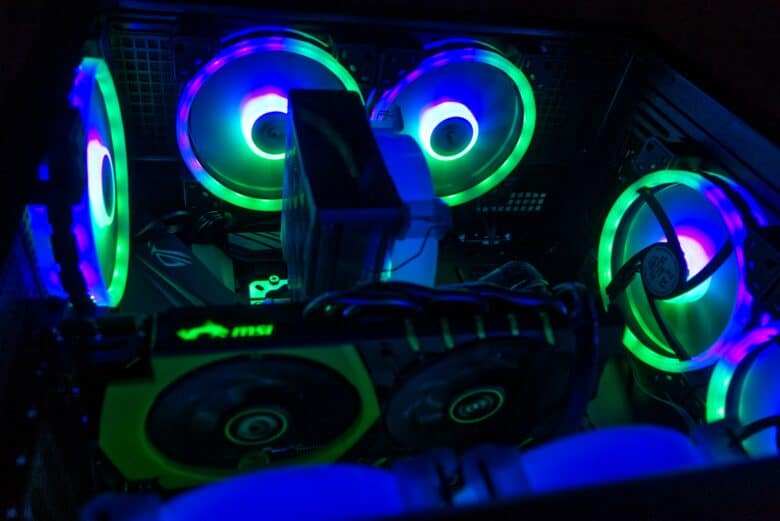


The temperatures are given as a delta in Kelvin. This means that the difference to the room temperature was measured here. So, with a delta of 30 K and a room temperature of 21°C, you have to add these together and you end up with a temperature of 51°C of the measured component. This means that smaller results are better.
For the test procedure, a stress test was run with 3DMark Night Raid, with the fans from the processor (CPU) (AMD Ryzen 5 3600X, cooled with a DeepCool AK400) and the graphics card (GPU) GeForce GTX 960 fixed at an unchanging speed to avoid being influenced by automatics. The system sits in a DeepCool CH510 Mesh Digital. The volume measurement describes the overall system in the room.
At a uniform 800 RPM speed
In terms of uniform speed, the Arctic fan is the all-around winner, offering the best temperatures at the lowest noise levels. Practically speaking, though, the differences aren’t huge. The Corsair fans and the Inter-Tech Argus RS-14 are also quite quiet fans overall, and the drop in performance is measurable at the same speed, but in the practically irrelevant range.
At uniformly low volume
When compared on volume normalized, quieter fans naturally offer higher performance. For example, the Arctic P14s can be spun faster than in the last test, which boosts performance. The Corsair fans have to lose a little bit of speed and the Inter-Tech Argus RS-14 run noticeably slower to end up at the inaudible limit. Accordingly, the performance differences increase.
At maximum performance
In this test, the results stretch even further according to the maximum speed. The Arctic P14s achieve the best performance on average, with the much slower spinning Corsair QL140 at least able to keep the graphics card at a minimally better temperature. The Inter-Tech Argus RS-14, on the other hand, beat the Corsair fans in terms of processor temperature, but are clearly behind the Arctic P14 overall. This is especially due to the lower maximum speed, which in turn has another advantage: At maximum power, the Inter-Tech Argus RS-14s remain quieter than the other models in the test. So they remain more inconspicuous even when automatic fans crank up their performance.
Power on the Radiator
- Moderate performance
- Relatively quiet
An overclocked AMD Ryzen 9 5950X is used in these tests, cooled by an Arctic Liquid Freezer II 280 mm. The radiator sits in the front of a Fractal Design Pop XL Air.
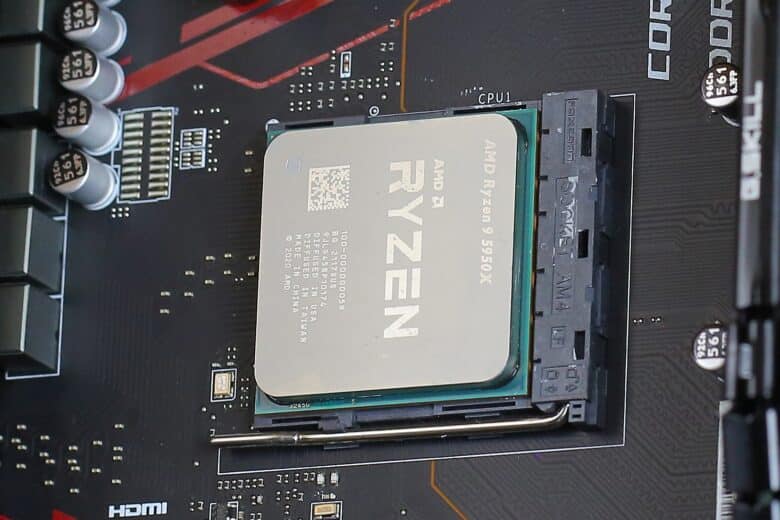


For the fan test, the water cooler is heated up for 10 minutes each by the continuous loop in Cinebench R23, then the processor temperature is measured for one minute and, as before in the case fan tests, adjusted for room temperature. The same criteria are used for testing, even though only the processor temperature is relevant here.
At uniform 800 RPM speed
The results of the case fan tests similarly follow through here: The Arctic P14s are the most powerful fans in the test, with the gap between the Corsair QL140 and Inter-Tech Argus RS-14s narrowing in this test. The volume of all three fans is very low here, with the Argus RS-14 coming out minimally quieter once again.
At uniformly low volume
Still, the Inter-Tech Argus RS-14s need to be turned down considerably further to reach the limit of inaudible. In this test, the performance gap between the Arctic fans and the Inter-Tech fans remains similar, but the Corsair QL140s lose less power.
At maximum power
The picture repeats itself: the Arctic P14s are the fastest fans and thus also achieve the best performance. The Corsair QL140s perform slightly better than the Inter-Tech Argus RS-14s in this test, but they are noticeably quieter thanks to their lower speed.
Conclusion
Yes, the Inter-Tech Argus RS-14s are not powerful fans. But even though they take the back seats in virtually every test, at least they do it in style. After all, such intense lighting is already hard to find otherwise, and then even more so hardly at this price. And where the performance itself is not outstanding, the gap is at least not huge and the volume always scores well, too. Moreover, you get a lot of fans for cheap, which can compensate for the performance disadvantage due to the quantity. Apart from that, the controller included in the scope of delivery is an advantage, because it can be used to illuminate the fans sensibly even if the motherboard does not have the corresponding connectors. Thus, you don’t have to do without a good look for budget computers. Overall, the Inter-Tech Argus RS-14 fans are not for ambitious enthusiasts. But they are definitely an option not to be underestimated for people who have to manage on a limited budget.
Workmanship
Cooling performance
Loudness
Features
Value for money
76/100
The Inter-Tech Argus RS-14 are inexpensive 140mm fans with powerful RGB lighting and where pure cooling performance is mediocre, these fans remain fairly quiet.
Inter-Tech Argus RS-14 Set price comparison
By purchasing via the links from our price comparison, you support our editorial work without incurring additional costs. We thank you for your support.


